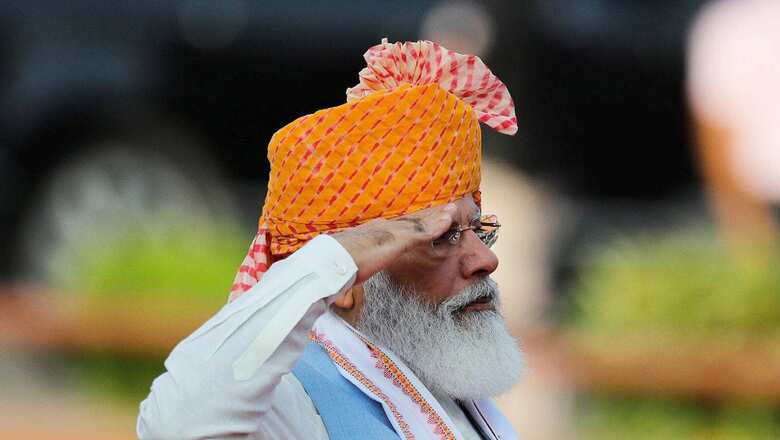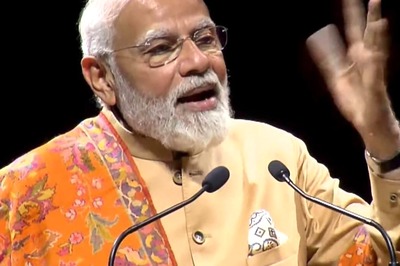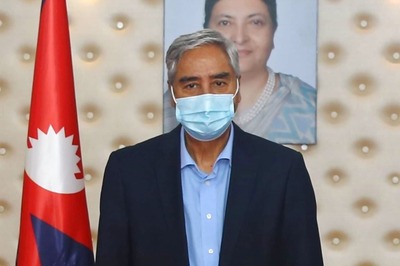
views
The national master plan for the Pradhan Mantri GatiShakti project to be unveiled by Prime Minister Narendra Modi on October 13 fixes mega infrastructure and connectivity targets for India by 2024-25, which could become Modi’s showpiece achievement while seeking yet another term in office in 2024.
This includes having a network of 2 lakh km of national highways, trains handling cargo of 1,600 million tonnes (MT), doubling gas pipeline network to 35,000 km, having total 220 airports, airstrips and aerodromes, a 25000-acre area developed for industries, including 11 industrial corridors, achieving a Rs 1.7 lakh crore turnover in defence production and having 38 electronics manufacturing clusters and 109 pharma clusters by 2024-25.
“In the proposed national master plan, all existing and proposed economic zones have been mapped along with the multimodal connectivity infrastructure in a single platform ranging in three time periods, i.e., status as on 2014-15, achievements made by 2020-21 and planned interventions up to 2024-25 for movement of people, goods and services. The comprehensive map provides a bird’s eye view of infrastructure development with key layers based on completion timelines of various economic zones, infrastructure and utilities across the country,” says an official note on the PM GatiShakti project accessed by News18.
Sixteen central departments are part of the national master plan which is ready. The government will set up an Empowered Group of Secretaries (EGoS) of all these departments under the chairmanship of the Cabinet Secretary for approving any changes in the master plan to meet any emerging requirements till 2024-25.
An Integrated Multimodal Network Planning Group (NPG) with senior officials will be responsible for unified planning and integration of these proposals. The NPG will also examine infrastructure connectivity projects of over Rs 500 crore which are outside the master plan currently as their DPRs have either been completed or in advanced stage.
The Big Connectivity Targets
The national master plan fixes targets up to 2024-25 for all infrastructure ministries. Like for the Road Transport and Highways Ministry, the target is having National Highways of 2 lakh km, completion of four or six lane national highways of 5,590 km along coastal areas and all state capitals in north-east to be connected with four-lane national highways or two two-lane national highways.
For Railways, the target by 2024-25 is to handle cargo of 1,600 million tonnes from 1,210 million tons in 2020, decongesting 51% of Railway network by completing additional lines and implementation of two Dedicated Freight Corridors (DFCs).
Also, detailed project reports are to be prepared for 4,000 km of East-West, North-South and East coast DFCs to be built in the public-private partnership mode.
In Civil Aviation, the target is to double the existing aviation footprint to have a total of 220 airports, heliports and water aerodromes by 2025 which would mean building additional 109 such facilities by then.
In Shipping, the national masterplan says the target by 2024-25 is to have total cargo capacity to be handled at the ports at 1,759 MMTPA from 1,282 MMTPA in 2020, cargo movement on all national waterways will be 95 million MT from 74 million MT in 2020 and cargo movement on Ganga river will be increased from 9 million MT in 2020 to a massive 29 million. The plan aims to ensure round-the-year movement of vessels between Varanasi and Sadiya, and Badarpur and Karimganj through the Indo-Bangladesh protocol.
The gas pipeline network in the country is aimed to be doubled to 34,500 km by 2024-25 by building an additional 17,000 km long trunk pipeline connecting major demand and supply centres for industries, as per the plan. The target is to connect all states with the trunk Natural Gas Pipeline Network by 2027.
In Power lines, the total transmission network by 2024-25 is targeted to be 4.52 lakh circuit km and the renewable energy capacity will be increased to 225 GW from 87.7 GW presently, with the aim to generate 35% of all electricity in the country by this channel by year 2024.
For the Telecommunications department, the target is 35 lakh km of Optical Fibre Network (OFC) to be laid by 2024, including connecting all villages of the country with OFC by 2023 and with 4G mobile connectivity by 2022.
The Big Infrastructure Targets
Targets for 2024-25 have also been set under the PM Gatishakti National Masterplan for the economic zones ministries. The big bump is expected in defence production with development of two defence corridors in Uttar Pradesh and Tamil Nadu with a targeted investment of Rs 10,000 crore each for the two corridors by 2024-25. The government is also targeting a turnover of Rs 1,70,000 crore, including export of Rs 35,000 crore in aerospace and defence goods and services by 2025.
The government is also targeting developing a total area of 25,000 acres and 11 industrial corridors, including greenfield smart industrial cities with sustainable, ‘plug n play’, and ICT enabled utilities to facilitate manufacturing investments into the country and position India as a strong player in global value chain.
“The aim is to provide quality, reliable, sustainable and resilient infrastructure for industries,” the note on the national master plan says.
In the Food Processing Ministry, the target is to have 197 mega food parks and agro processing centres, a one district-one product approach; and increasing nearly four times the food processing and preservation capacity to 847 lakh MT (from 222 MT at present). The number of fishing clusters, harbours and major landing centres will be increased to 202 to achieve additional fish production of 70 lakh MT and doubling of fisheries exports.
Another target is to have 38 electronics manufacturing clusters by 2024-25 with total production in these clusters expected to be Rs 15 lakh crore by then. This will involve the development of 23 new clusters with plug & play facilities.
The total pharma and medical device clusters are expected to reach 109 by 2024-25 with development of 10 new pharma clusters by financing common facilities worth Rs 20 crore each and establishment of three bulk drug parks and four medical device parks which are expected to reduce dependence of the country on imports of APIs and medical devices.
The country is also expected to have 90 textile clusters or parks by 2025.
Read all the Latest News , Breaking News and IPL 2022 Live Updates here.




















Comments
0 comment